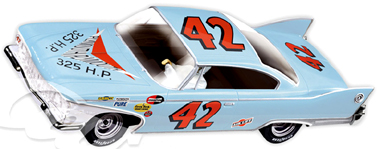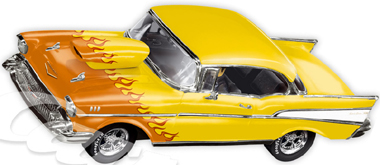2008 New Releases:
Information about the various manufacturers' prodict lines is filtering out from the Nurnberg Toy Fair and elsewhere. Here are some of the highlights:
Carrera:
We now have all the 2008 Carrera 1:32 scale race sets and cars on line and available for preorder, including these:

Carrera 27254 '60 Plymouth, Lee Petty. $41.69. Another Petty family car, but this time it's one driven by the founder and patriarch, Lee Petty, a year or two before Richard got into the act. The 60 Plymouth also comes in 2 street versions, and as a custom, as well as in Digital 132.

Carrera 27259 '57 Chevy custom. $41.69 The car we all wanted when we were kids. It will be available in several versions in both conventional and digital.

Carrera 27265 DeKon Monza. $41.69. These cars ruled IMSA for a couple of seasons and were some of the coolest looking race cars ever built.
We don't have the Carrera 1/24 cars on line yet, but there are 2 versions each of the Ferrari 250 GTO and the Corvette Grand Sport.
Also, we are bringing in the Carrera GO! 1/43 scale product line. We think 1/43 scale is about to take off and that it will soon evolve from a toy to a scale for serious racers and modelers. Meanwhile, 1/43 scale is a compact, low-cost option for those who want to give their children an introduction to slot car racing but don't know how it will be received. With GO! they can give it a low-risk try with minimal financial investment. The first shipment will be arriving soon, and we will have all the new cars and sets for 2008 as they are released.
The Year of the Daytona Prototype
.jpg)
By now you know that Fly is releasing its new "Flyer" line of cars beginning with the 2007 GrandAm Daytona Prototype Chamopion Gainsco Racing car, due in March. Now there is an even more exciting announcement from Racer Products. They will be releasing their first plastic (instead of resin-cast) car this year and it will also be a Riley Daytona Prototype.

Racer has a license from Riley to produce the 2008 version of the car, while Fly's car will be the 2007 and earlier version. Racer's car will be priced comparable to other plastic RTR cars on the market and may be powered by...

Slot It's new ultra low-profile Flat 6 motor. The Flat 6 lowers a car's center of gravity while retaining the standard shaft size, inlike the slim-line motors being used in many formula car models, so you will be able to use a standard pinion gear on it. As you can see above, it's considerably lower than Slot It's own popular Boxer motor.
The Flat 6 will be available in three different models.
MN09H
Flat-6 20,500rpm - 200g*cm @12v
10g magnetic traction
MN11H
Flat-6R 23,000rpm - 200g*cm @12v
22g magnetic traction
MN11C
Flat-6R 23,000rpm - 200g*cm @12v
6g magnetic traction
The Flat 6 will also come in a new Slot IT Audi R8C with a newly tooled body and an anglewinder chassis.

You can expect the Flat 6 to set off a wave of engineering advancement and also to make possible models of some cars that previous motors just wouldn't fit.
aThese are just a few of the high points for 2008. We will be adding information to our web site as we receive it. Check our New Releases 2008 section frequently.
New Items In Stock:

LeMans Miniatures 13219-53M Panhard CD #53 RTR car. $107.95. This car was a class winner at LeMans in 1962.
Also available are RTR models of the #54 and#55 cars that made up the rest of the Panhard team that year.

LeMans Miniatures 132020M Audi R10, 2007 Sebring winner. $151.95
Thanks for shopping with us!
The Electric Dream Team
 The bodies on all four
The bodies on all four  All the body details are there, including the wildly flared fenders, big hood hump, and the classic Corvette hardtop with rear window straps. The radiator inlet and rear fender vents feature photo-etched screens. Interior details include a full roll cage, instrument panel, rear-view mirror, shift lever, and fire system. The driver, with full-face helmet, 5-point racing harness, and detailed driving suit, looks at home in the car. The only paint flaw we could find on any of our review cars (the Riverside, the Sebring, and the Mancuso) was less-than crisp color demarcation between the blue and the white on the Sebring car. Otherwise, both the paint masking and the tampo-stamping were of extremely high quality. The finish on all three cars was glossy and free from dust specks and orange peel. RM earns an attaboy for not letting political correctness keep them from putting the Joe Camel decals on the IMSA cars.
All the body details are there, including the wildly flared fenders, big hood hump, and the classic Corvette hardtop with rear window straps. The radiator inlet and rear fender vents feature photo-etched screens. Interior details include a full roll cage, instrument panel, rear-view mirror, shift lever, and fire system. The driver, with full-face helmet, 5-point racing harness, and detailed driving suit, looks at home in the car. The only paint flaw we could find on any of our review cars (the Riverside, the Sebring, and the Mancuso) was less-than crisp color demarcation between the blue and the white on the Sebring car. Otherwise, both the paint masking and the tampo-stamping were of extremely high quality. The finish on all three cars was glossy and free from dust specks and orange peel. RM earns an attaboy for not letting political correctness keep them from putting the Joe Camel decals on the IMSA cars.  The chassis has some excellent frame rail and exhaust detail along the sides. Mechanically, it’s a front motor with drive shaft layout using the familiar s-can motor. The rear tires are wide and put lots of rubber on the track surface, but there’s room for even wider aftermarket wheels if you choose to fit them. The traction magnet slides fore and aft in its mount, though I didn’t observe much difference in handling, if any, between the full forward and full aft positions.
The chassis has some excellent frame rail and exhaust detail along the sides. Mechanically, it’s a front motor with drive shaft layout using the familiar s-can motor. The rear tires are wide and put lots of rubber on the track surface, but there’s room for even wider aftermarket wheels if you choose to fit them. The traction magnet slides fore and aft in its mount, though I didn’t observe much difference in handling, if any, between the full forward and full aft positions.  Even so, the combination of wide tires and magnet downforce gives good cornering performance on our Scalextric sport test track. The track-test car (a Mancuso) handled a bit more on-rails than I prefer, but the grip was ferocious and when the car did break loose it spun, it didn’t tumble. RM’s designers appear to have taken the magnetic downforce right to the limit of increasing traction without smothering the car’s driving characteristics and making it boring to drive. Like all magnet cars do to one degree or another this one will break away without warning at the limit, but the limit is quite high. My best lap time with the car was 4.450 sec. For comparison purposes I ran some laps with what has come to be my “benchmark” car, a
Even so, the combination of wide tires and magnet downforce gives good cornering performance on our Scalextric sport test track. The track-test car (a Mancuso) handled a bit more on-rails than I prefer, but the grip was ferocious and when the car did break loose it spun, it didn’t tumble. RM’s designers appear to have taken the magnetic downforce right to the limit of increasing traction without smothering the car’s driving characteristics and making it boring to drive. Like all magnet cars do to one degree or another this one will break away without warning at the limit, but the limit is quite high. My best lap time with the car was 4.450 sec. For comparison purposes I ran some laps with what has come to be my “benchmark” car, a  85-4855
85-4855  85-4857
85-4857  85-4864 Arie Viewer May 24, 2006
85-4864 Arie Viewer May 24, 2006







